Business Communication Report: Workplace Cultural Diversity Analysis
VerifiedAdded on 2021/01/03
|6
|1357
|94
Report
AI Summary
This report delves into the intricacies of business communication, exploring the significance of culture and language in effective information exchange. It examines the three levels of culture—organizational, team, and individual—and their impact on communication dynamics. The report further analyzes the relationship between culture and language, emphasizing how language reflects cultural values and influences interactions. It identifies and discusses key barriers to intercultural communication, such as language differences, behavioral variations, and cultural disparities. Finally, the report addresses cultural differences within the workplace, highlighting the importance of understanding and managing cultural diversity to enhance productivity and foster a harmonious work environment. The report concludes by summarizing the key findings and emphasizing the importance of effective communication in a diverse business setting.
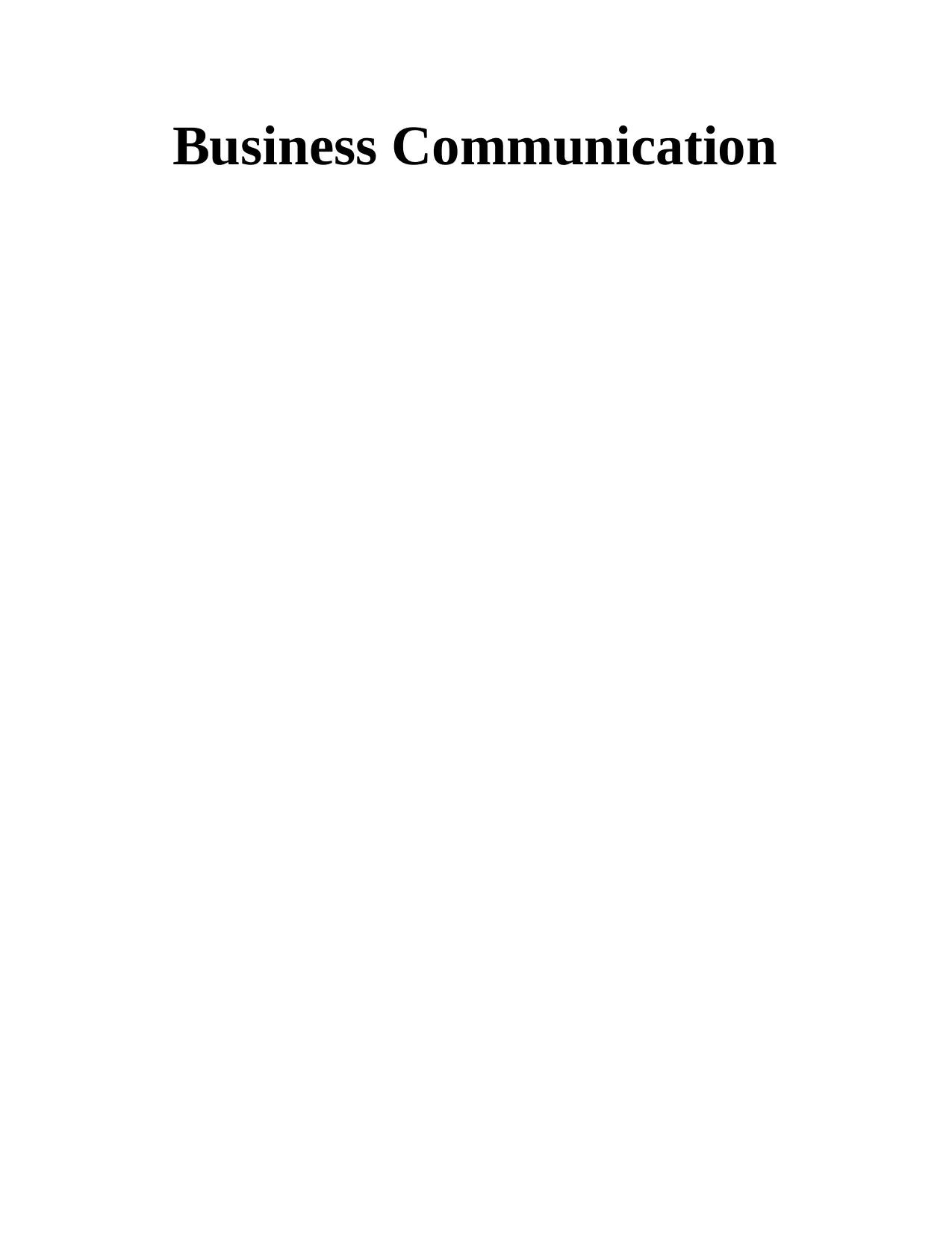
Business Communication
Paraphrase This Document
Need a fresh take? Get an instant paraphrase of this document with our AI Paraphraser
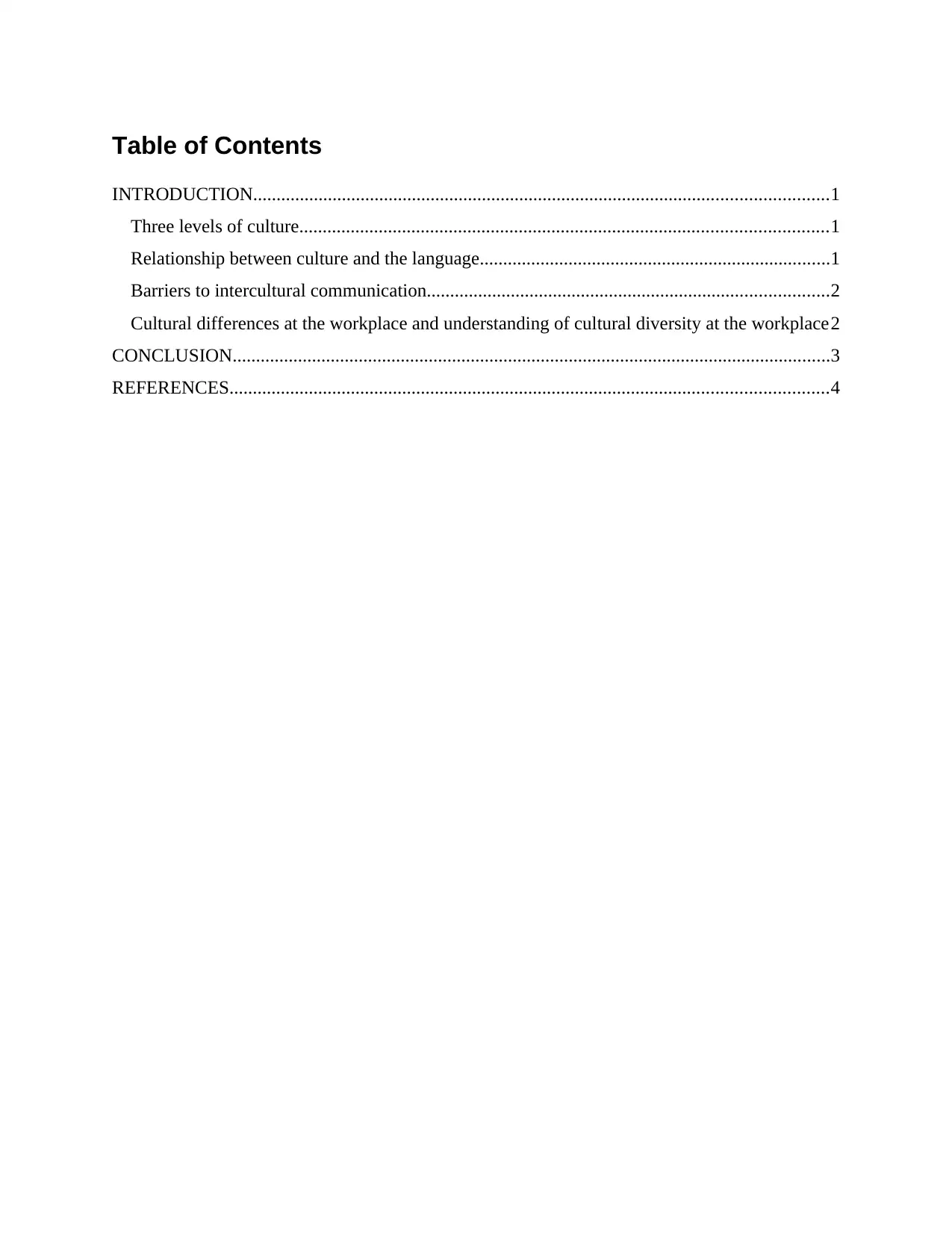
Table of Contents
INTRODUCTION...........................................................................................................................1
Three levels of culture.................................................................................................................1
Relationship between culture and the language...........................................................................1
Barriers to intercultural communication......................................................................................2
Cultural differences at the workplace and understanding of cultural diversity at the workplace2
CONCLUSION................................................................................................................................3
REFERENCES................................................................................................................................4
INTRODUCTION...........................................................................................................................1
Three levels of culture.................................................................................................................1
Relationship between culture and the language...........................................................................1
Barriers to intercultural communication......................................................................................2
Cultural differences at the workplace and understanding of cultural diversity at the workplace2
CONCLUSION................................................................................................................................3
REFERENCES................................................................................................................................4
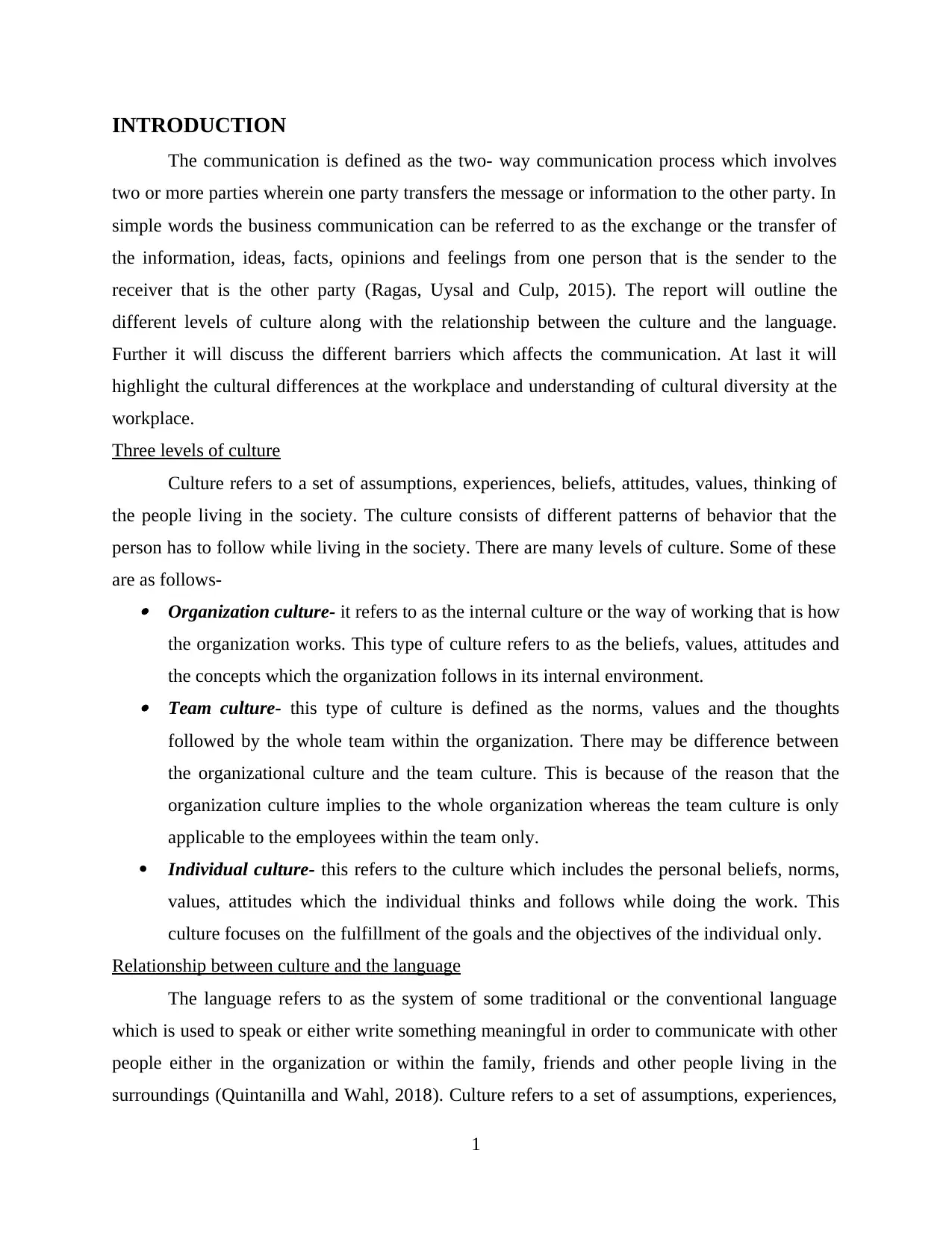
INTRODUCTION
The communication is defined as the two- way communication process which involves
two or more parties wherein one party transfers the message or information to the other party. In
simple words the business communication can be referred to as the exchange or the transfer of
the information, ideas, facts, opinions and feelings from one person that is the sender to the
receiver that is the other party (Ragas, Uysal and Culp, 2015). The report will outline the
different levels of culture along with the relationship between the culture and the language.
Further it will discuss the different barriers which affects the communication. At last it will
highlight the cultural differences at the workplace and understanding of cultural diversity at the
workplace.
Three levels of culture
Culture refers to a set of assumptions, experiences, beliefs, attitudes, values, thinking of
the people living in the society. The culture consists of different patterns of behavior that the
person has to follow while living in the society. There are many levels of culture. Some of these
are as follows- Organization culture- it refers to as the internal culture or the way of working that is how
the organization works. This type of culture refers to as the beliefs, values, attitudes and
the concepts which the organization follows in its internal environment. Team culture- this type of culture is defined as the norms, values and the thoughts
followed by the whole team within the organization. There may be difference between
the organizational culture and the team culture. This is because of the reason that the
organization culture implies to the whole organization whereas the team culture is only
applicable to the employees within the team only.
Individual culture- this refers to the culture which includes the personal beliefs, norms,
values, attitudes which the individual thinks and follows while doing the work. This
culture focuses on the fulfillment of the goals and the objectives of the individual only.
Relationship between culture and the language
The language refers to as the system of some traditional or the conventional language
which is used to speak or either write something meaningful in order to communicate with other
people either in the organization or within the family, friends and other people living in the
surroundings (Quintanilla and Wahl, 2018). Culture refers to a set of assumptions, experiences,
1
The communication is defined as the two- way communication process which involves
two or more parties wherein one party transfers the message or information to the other party. In
simple words the business communication can be referred to as the exchange or the transfer of
the information, ideas, facts, opinions and feelings from one person that is the sender to the
receiver that is the other party (Ragas, Uysal and Culp, 2015). The report will outline the
different levels of culture along with the relationship between the culture and the language.
Further it will discuss the different barriers which affects the communication. At last it will
highlight the cultural differences at the workplace and understanding of cultural diversity at the
workplace.
Three levels of culture
Culture refers to a set of assumptions, experiences, beliefs, attitudes, values, thinking of
the people living in the society. The culture consists of different patterns of behavior that the
person has to follow while living in the society. There are many levels of culture. Some of these
are as follows- Organization culture- it refers to as the internal culture or the way of working that is how
the organization works. This type of culture refers to as the beliefs, values, attitudes and
the concepts which the organization follows in its internal environment. Team culture- this type of culture is defined as the norms, values and the thoughts
followed by the whole team within the organization. There may be difference between
the organizational culture and the team culture. This is because of the reason that the
organization culture implies to the whole organization whereas the team culture is only
applicable to the employees within the team only.
Individual culture- this refers to the culture which includes the personal beliefs, norms,
values, attitudes which the individual thinks and follows while doing the work. This
culture focuses on the fulfillment of the goals and the objectives of the individual only.
Relationship between culture and the language
The language refers to as the system of some traditional or the conventional language
which is used to speak or either write something meaningful in order to communicate with other
people either in the organization or within the family, friends and other people living in the
surroundings (Quintanilla and Wahl, 2018). Culture refers to a set of assumptions, experiences,
1
⊘ This is a preview!⊘
Do you want full access?
Subscribe today to unlock all pages.

Trusted by 1+ million students worldwide
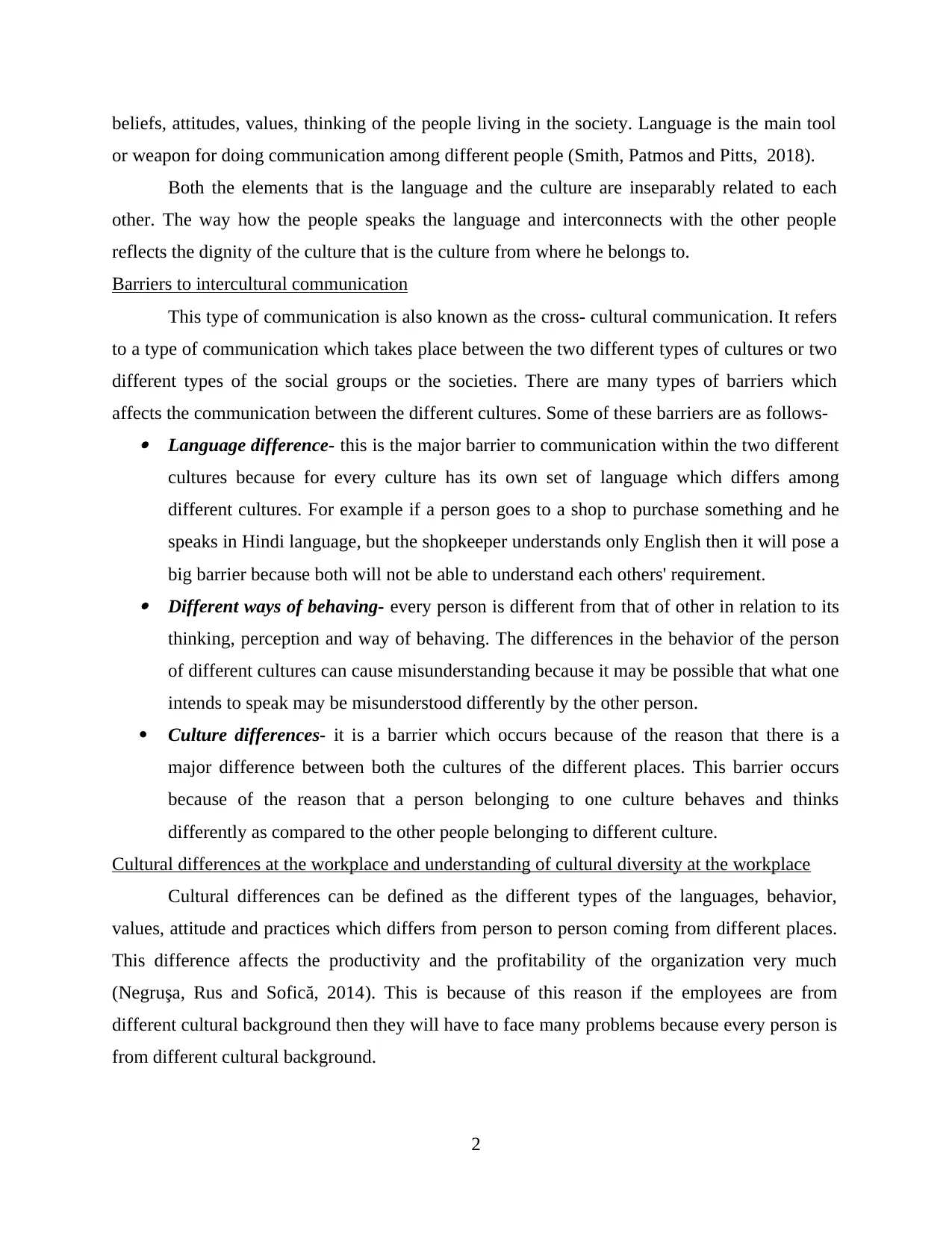
beliefs, attitudes, values, thinking of the people living in the society. Language is the main tool
or weapon for doing communication among different people (Smith, Patmos and Pitts, 2018).
Both the elements that is the language and the culture are inseparably related to each
other. The way how the people speaks the language and interconnects with the other people
reflects the dignity of the culture that is the culture from where he belongs to.
Barriers to intercultural communication
This type of communication is also known as the cross- cultural communication. It refers
to a type of communication which takes place between the two different types of cultures or two
different types of the social groups or the societies. There are many types of barriers which
affects the communication between the different cultures. Some of these barriers are as follows- Language difference- this is the major barrier to communication within the two different
cultures because for every culture has its own set of language which differs among
different cultures. For example if a person goes to a shop to purchase something and he
speaks in Hindi language, but the shopkeeper understands only English then it will pose a
big barrier because both will not be able to understand each others' requirement. Different ways of behaving- every person is different from that of other in relation to its
thinking, perception and way of behaving. The differences in the behavior of the person
of different cultures can cause misunderstanding because it may be possible that what one
intends to speak may be misunderstood differently by the other person.
Culture differences- it is a barrier which occurs because of the reason that there is a
major difference between both the cultures of the different places. This barrier occurs
because of the reason that a person belonging to one culture behaves and thinks
differently as compared to the other people belonging to different culture.
Cultural differences at the workplace and understanding of cultural diversity at the workplace
Cultural differences can be defined as the different types of the languages, behavior,
values, attitude and practices which differs from person to person coming from different places.
This difference affects the productivity and the profitability of the organization very much
(Negruşa, Rus and Sofică, 2014). This is because of this reason if the employees are from
different cultural background then they will have to face many problems because every person is
from different cultural background.
2
or weapon for doing communication among different people (Smith, Patmos and Pitts, 2018).
Both the elements that is the language and the culture are inseparably related to each
other. The way how the people speaks the language and interconnects with the other people
reflects the dignity of the culture that is the culture from where he belongs to.
Barriers to intercultural communication
This type of communication is also known as the cross- cultural communication. It refers
to a type of communication which takes place between the two different types of cultures or two
different types of the social groups or the societies. There are many types of barriers which
affects the communication between the different cultures. Some of these barriers are as follows- Language difference- this is the major barrier to communication within the two different
cultures because for every culture has its own set of language which differs among
different cultures. For example if a person goes to a shop to purchase something and he
speaks in Hindi language, but the shopkeeper understands only English then it will pose a
big barrier because both will not be able to understand each others' requirement. Different ways of behaving- every person is different from that of other in relation to its
thinking, perception and way of behaving. The differences in the behavior of the person
of different cultures can cause misunderstanding because it may be possible that what one
intends to speak may be misunderstood differently by the other person.
Culture differences- it is a barrier which occurs because of the reason that there is a
major difference between both the cultures of the different places. This barrier occurs
because of the reason that a person belonging to one culture behaves and thinks
differently as compared to the other people belonging to different culture.
Cultural differences at the workplace and understanding of cultural diversity at the workplace
Cultural differences can be defined as the different types of the languages, behavior,
values, attitude and practices which differs from person to person coming from different places.
This difference affects the productivity and the profitability of the organization very much
(Negruşa, Rus and Sofică, 2014). This is because of this reason if the employees are from
different cultural background then they will have to face many problems because every person is
from different cultural background.
2
Paraphrase This Document
Need a fresh take? Get an instant paraphrase of this document with our AI Paraphraser
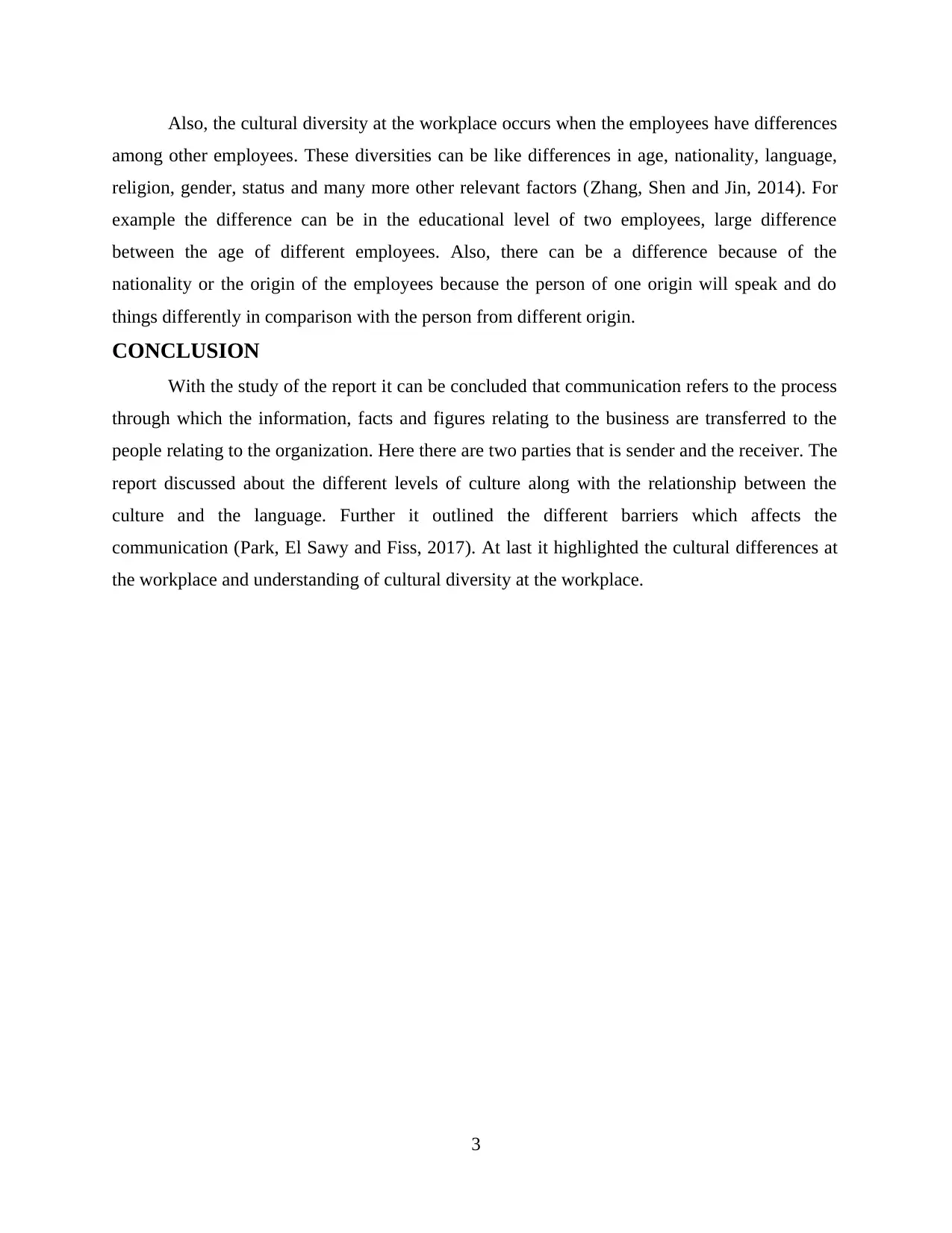
Also, the cultural diversity at the workplace occurs when the employees have differences
among other employees. These diversities can be like differences in age, nationality, language,
religion, gender, status and many more other relevant factors (Zhang, Shen and Jin, 2014). For
example the difference can be in the educational level of two employees, large difference
between the age of different employees. Also, there can be a difference because of the
nationality or the origin of the employees because the person of one origin will speak and do
things differently in comparison with the person from different origin.
CONCLUSION
With the study of the report it can be concluded that communication refers to the process
through which the information, facts and figures relating to the business are transferred to the
people relating to the organization. Here there are two parties that is sender and the receiver. The
report discussed about the different levels of culture along with the relationship between the
culture and the language. Further it outlined the different barriers which affects the
communication (Park, El Sawy and Fiss, 2017). At last it highlighted the cultural differences at
the workplace and understanding of cultural diversity at the workplace.
3
among other employees. These diversities can be like differences in age, nationality, language,
religion, gender, status and many more other relevant factors (Zhang, Shen and Jin, 2014). For
example the difference can be in the educational level of two employees, large difference
between the age of different employees. Also, there can be a difference because of the
nationality or the origin of the employees because the person of one origin will speak and do
things differently in comparison with the person from different origin.
CONCLUSION
With the study of the report it can be concluded that communication refers to the process
through which the information, facts and figures relating to the business are transferred to the
people relating to the organization. Here there are two parties that is sender and the receiver. The
report discussed about the different levels of culture along with the relationship between the
culture and the language. Further it outlined the different barriers which affects the
communication (Park, El Sawy and Fiss, 2017). At last it highlighted the cultural differences at
the workplace and understanding of cultural diversity at the workplace.
3
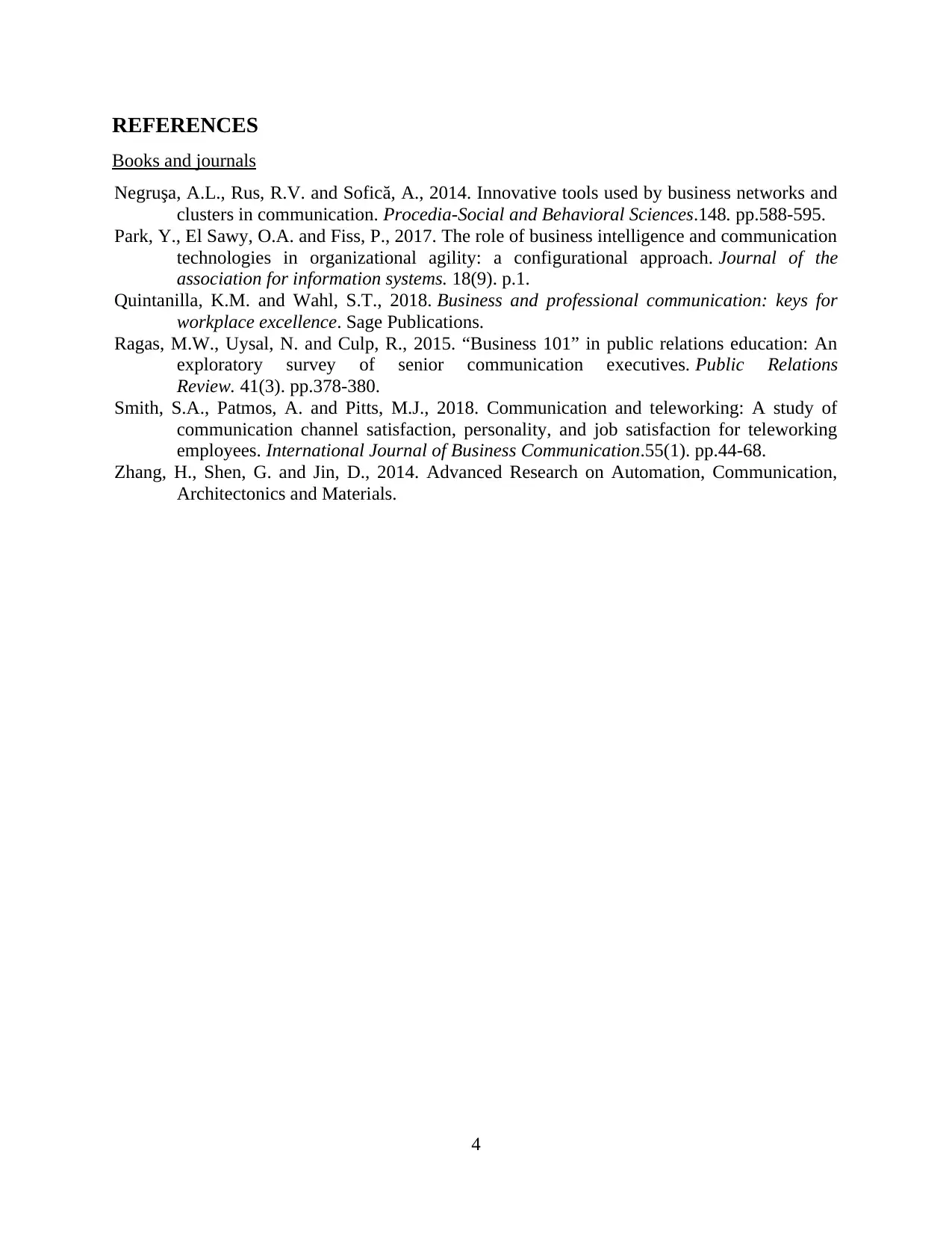
REFERENCES
Books and journals
Negruşa, A.L., Rus, R.V. and Sofică, A., 2014. Innovative tools used by business networks and
clusters in communication. Procedia-Social and Behavioral Sciences.148. pp.588-595.
Park, Y., El Sawy, O.A. and Fiss, P., 2017. The role of business intelligence and communication
technologies in organizational agility: a configurational approach. Journal of the
association for information systems. 18(9). p.1.
Quintanilla, K.M. and Wahl, S.T., 2018. Business and professional communication: keys for
workplace excellence. Sage Publications.
Ragas, M.W., Uysal, N. and Culp, R., 2015. “Business 101” in public relations education: An
exploratory survey of senior communication executives. Public Relations
Review. 41(3). pp.378-380.
Smith, S.A., Patmos, A. and Pitts, M.J., 2018. Communication and teleworking: A study of
communication channel satisfaction, personality, and job satisfaction for teleworking
employees. International Journal of Business Communication.55(1). pp.44-68.
Zhang, H., Shen, G. and Jin, D., 2014. Advanced Research on Automation, Communication,
Architectonics and Materials.
4
Books and journals
Negruşa, A.L., Rus, R.V. and Sofică, A., 2014. Innovative tools used by business networks and
clusters in communication. Procedia-Social and Behavioral Sciences.148. pp.588-595.
Park, Y., El Sawy, O.A. and Fiss, P., 2017. The role of business intelligence and communication
technologies in organizational agility: a configurational approach. Journal of the
association for information systems. 18(9). p.1.
Quintanilla, K.M. and Wahl, S.T., 2018. Business and professional communication: keys for
workplace excellence. Sage Publications.
Ragas, M.W., Uysal, N. and Culp, R., 2015. “Business 101” in public relations education: An
exploratory survey of senior communication executives. Public Relations
Review. 41(3). pp.378-380.
Smith, S.A., Patmos, A. and Pitts, M.J., 2018. Communication and teleworking: A study of
communication channel satisfaction, personality, and job satisfaction for teleworking
employees. International Journal of Business Communication.55(1). pp.44-68.
Zhang, H., Shen, G. and Jin, D., 2014. Advanced Research on Automation, Communication,
Architectonics and Materials.
4
⊘ This is a preview!⊘
Do you want full access?
Subscribe today to unlock all pages.

Trusted by 1+ million students worldwide
1 out of 6
Related Documents
Your All-in-One AI-Powered Toolkit for Academic Success.
+13062052269
info@desklib.com
Available 24*7 on WhatsApp / Email
![[object Object]](/_next/static/media/star-bottom.7253800d.svg)
Unlock your academic potential
Copyright © 2020–2025 A2Z Services. All Rights Reserved. Developed and managed by ZUCOL.





